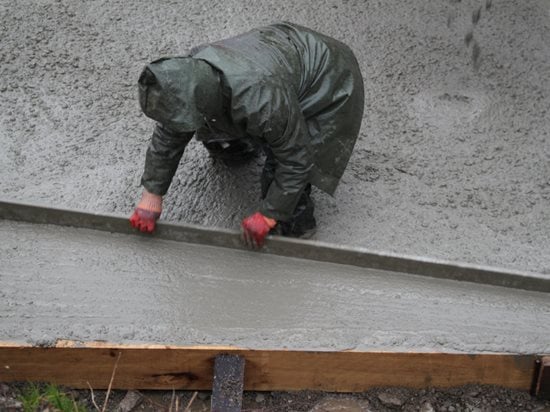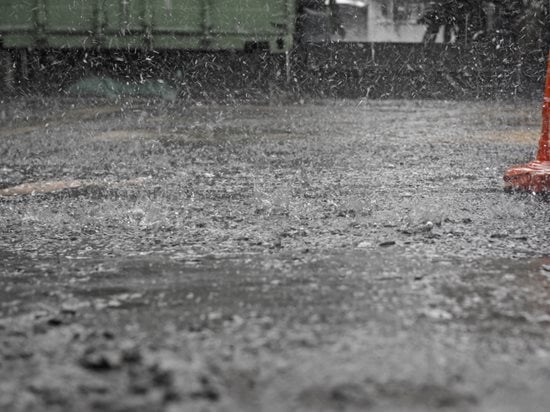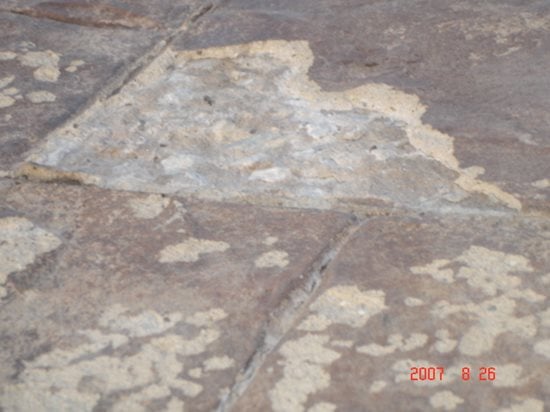- Staining Concrete
- Stamped Concrete
- Concrete Overlays
- Concrete Resurfacing
- Concrete Polishing
- Concrete Dyes
- Colored Concrete
- Indoor Concrete
- Concrete Floors
- Concrete Countertops
- Garage Floor Coatings
- Furniture, Sinks, Fire Bowls
- Basement Floors
- Outdoor Concrete
- Concrete Patios
- Concrete Driveways
- Concrete Pool Decks
- Outdoor Kitchens & Counters
- Outdoor Fireplace
- Concrete Walkways
- Concrete Pavers
- Concrete Walls
- Repair & Maintenance
- Foundation Repair
- Concrete Crack Repair
- Concrete Sealers
- Building with Concrete
- Concrete Homes
- Concrete Basements
- Decorative Concrete
- Fire Resistant
Pouring Concrete in Rain: Expert Tips and Best Practices
Predicting the weather is tricky, but you can take steps to prevent rain from ruining your concrete project.
Pouring concrete in the rain is not only miserable, but it can also lead to problems with the final surface strength. Photo by: ESTELLE R/Shutterstock.
Water is a key component of all concrete, mixing with cement and causing it to hydrate and gain strength. But after freshly mixed concrete has been placed, water in the form of a driving rain can do much more harm than good. Pouring concrete in the rain can compromise its strength, increasing the tendency for dusting and scaling to develop.
Once the damage is done, it can be hard to rectify and will often ruin the appearance of the finished surface. Don’t let it rain on your parade. Here are some tips for preventing and troubleshooting rain-damaged concrete.
30-Second Summary: Pouring Concrete in the Rain
- 🌧 Heavy Rain: Delay the pour. Prevent washout, weakened surfaces, and uneven curing.
- 🌦 Light Rain: Proceed if prepared. Cover with plastic immediately and remove standing water.
- ✔ Pro Tip: Check multiple forecasts and have a plan. Plastic, squeegees, and accelerators can help manage unexpected rain.
Advice for Pouring Concrete in Rain
Despite modern weather forecasting technology and radar maps, an unexpected rain shower can develop without warning, especially during the wettest months of the year (see these guidelines for placing concrete by region and season).
What the Pros Say
"Years ago, we would pour concrete even when the forecast called for a 30% chance of rain. Today, we will call a pour if there is a 20% chance of rain, and even then, I am watching the sky, making a game-time decision."
— C.J. Salzano of Salzano Custom Concrete, Centreville, Va.
If rain is in the forecast, you should postpone a large concrete pour until conditions improve. Even if rain isn’t predicted, you should always be prepared to cover the concrete work with a tarp or plastic sheeting just in case. Make sure to seal the edges so rainwater can’t seep underneath.
Also scope out the jobsite before the project begins, looking for the presence and location of gutters and downspouts. Rainwater gushing from downspouts or cascading over the edge of a roof without gutters will carve a trench into wet concrete if the slab is directly beneath the overflow.

Heavy rain after a concrete pour can be concerning if the concrete hasn’t been finished and had enough time for the intial curing process. Photo by: Mr.Note19/Shutterstock
Tips for Handling Rain After Pouring Concrete
Here’s how to react if it does pour down on your freshly placed concrete:
- Don’t work the rainwater into the concrete surface, this is the biggest mistake you can make.
- Don’t broadcast dry cement onto the concrete to soak up surface water. This will impair the finish and further weaken the top layer.
- Instead, once the rain passes, use a float to push the water off the edge of the slab before you start finishing.
How Long Does Concrete Take to Dry Before Rain?
Even if it starts raining after a concrete pour, the potential for damage may not be that serious. If you had time to complete the finishing process and the concrete has stiffened (typically 4 to 8 hours after mixing), rainwater may cause little if any damage.
What the Pros Say
"When we get caught in the rain, we always carry squeegees. The goal is to remove as much surface moisture as possible without pulling off the cream. If the rain stops, the surface can still dry up quickly and finish well."
— Mike Day, concrete contractor and YouTuber, North Monmouth, Me.
In fact, once concrete sets, water on the surface is actually beneficial because it aids in hydration and curing. A simple scratch test, using a screwdriver or Mohs concrete surface hardness scratch test kit, can be performed to assess the integrity of the surface and determine if the rain had any impact.
Why Opinions Differ on Pouring Concrete in the Rain
When it comes to pouring concrete in the rain, professionals don’t always agree. Some say light rain isn’t a problem, while others warn that even a small amount of extra moisture can weaken the slab. The truth? It depends on the situation.
Factors that impact whether rain is a problem:
- Type of Concrete Work – Foundations can often handle rain better than flatwork, where surface finish matters more.
- Timing of the Rain – If rain hits before finishing, it can be worked in. If it falls after setting begins, it may cause scaling and weakness.
- Rain Intensity – A light mist might not be an issue, but steady rain can wash out cement paste and create a weak top layer.
- Protective Measures – Covering freshly poured concrete or adjusting the mix can help minimize damage.
Solutions for Rain-Damaged Concrete

Surface scaling, or spalling, as seen on this stamped concrete, can be caused by rain weakening the surface strength of the concrete during or shortly after placement.
If the worst happens and the sky opens up on your fresh-from-the-truck concrete, it’s a good bet that the rain will wash some of the cement out of the concrete at the surface.
This is likely to lead to problems such as:
- Dusting
- Surface scaling
- Craze cracking (easily aggravated by freeze-thaw cycles)
If the concrete is integrally colored, rain on the day of the pour can also wash out some of the color and cause streaking.
Short of ripping out the concrete and starting over, the best remedy is to remove the weak surface layer by grinding and then resurface the concrete with an overlay, after making sure that the underlying concrete is structurally sound.
Other Problems Caused by Rain
Even before you place a concrete slab, rain can have a detrimental impact if it oversaturates the subgrade and causes ponding. That’s because the additional water can be absorbed by the fresh concrete and change the water-cement ratio.
If heavy rain is in the forecast a day or two before the pour, cover the ground with plastic sheeting to prevent it from becoming saturated. Learn more about subgrades and subbases for concrete slabs.
What the Pros Say
"If your sealer has water marks, blisters, or cloudiness caused by rain, a second coat will usually fix the issue. Just spray and back-roll to smooth it out.
— Chris Sullivan, Decorative Concrete Expert
Rain can also wreak havoc on freshly sealed concrete, causing the sealer to bubble and blister. Be sure to apply the sealer when it will remain rain-free for 24 hours after sealing. (See Rain Blisters on Freshly Placed Sealer.)
Frequently Asked Questions
We combed through forums and expert advice to find the most common concerns about pouring concrete in the rain&emdash;so you don’t have to scroll endlessly for answers. Here’s what you need to know:
Can curing compounds protect concrete from rain?
Curing compounds keep moisture in, not out. They help with proper curing but won’t protect against rain. They can wash away if applied too early and won’t fix any damage that’s already been done. Plastic sheeting or tarps are the best way to protect fresh concrete from rain.
How do contractors adjust concrete for rainy weather?
- Use a lower slump mix to prevent excess moisture from weakening the concrete.
- Add water-reducing admixtures to maintain workability without extra water.
- Use accelerators to speed up setting time before rain arrives.
Can adding extra cement help concrete set faster before rain?
No. Throwing dry cement on wet concrete won’t speed up setting and can weaken the surface, leading to dusting and scaling. Instead, use an accelerator, a lower slump mix, or schedule the pour earlier to allow more setting time before rain starts.
Does rain make concrete stronger by slowing down the drying process?
Some contractors say a little rain can serve the same pupose as water-curing. While, a light rain or mist might help keep the surface damp, heavy or variable rain can wash away cement paste, causing dusting or scaling. For concrete to gain strength, it needs even and consistent moisture—something rain can’t provide reliably.
Does covering fresh concrete with plastic cause discoloration?
Unfortunately, it can. Plastic sheeting can trap moisture and cause blotchy or darker areas if left for too long. To prevent this, remove the plastic as soon as the rain stops or create a tent-like cover using blocks to keep the plastic from touching the wet surface directly.
Sources
- Concrete Stamping Hindsight: ‘If I Knew Then, What I Know Now’ - ConcreteNetwork.com: Advice from C.J. Salzano on making game-time decisions based on rain forecasts. Read more
- Rain Blisters on Freshly Placed Sealer - ConcreteNetwork.com: Tips from Chris Sullivan on fixing sealer issues caused by rain. Read more
- The Surprising Truth About Fixing Rained On Concrete Nobody Tells You - Mike Day Concrete (Everything About Concrete) on YouTube: Advice from Mike Day, concrete contractor, on using squeegees to manage rainwater. Watch
- Pouring Concrete in Light Rain - ContractorTalk.com: Community insights on managing rain during a pour. View Thread
- Can Concrete be Poured in Rainy Conditions? - Quora.com: Insights and advice from professionals and DIYers. View Thread




